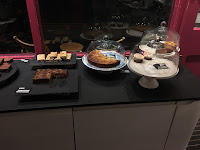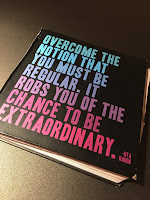One of my first memories is
baking with my mum, usually resenting her unfavourable addition of desiccated
coconut to our otherwise ‘perfect’ cake. But in the making, creating and
sharing of cake, I would argue, that there becomes a connection between family
and cake. So, instead of just writing about the experience of cake for others,
I decided to give it a go myself. I used the recipe for Victoria Sandwich cake
taken from The Great British Bake Off
cookbook. However, the recipe does not use a buttercream for the filling and
instead uses a whipped double cream, a variation I made due to my own
preference and my family’s sweet tooth.
For the sponge:
- 165g Caster Sugar (unfortunately I only had
granulated)
- 165g Butter
- 165g Self Raising flour
- 3 Medium eggs
- 1 tsp of Vanilla Essence (I do this to taste)
- 1 tbsp Milk (or by eye)
Utensils:

- Weighing scales
- Sieve
- Baking Tin(s)
- Mixing Bowl
- Spoon (I am an avid believer in the wooden spoon
as the only acceptable stirring utensil)
- Any number of cutlery (for any hitches along the way)
Method:
As I am not a fan of the ‘all in one’ method, I first
start by creaming the butter and sugar together.
* Weigh the butter before the sugar so it sticks to the remnants
of the butter, making it easier to scrape everything out so that no ingredients are wasted.
Next, slowly add the
beaten egg.
*I always beat
the egg until it creates a ‘froth’ at the top as I have found it creates a
lighter mixture.
*If you find you add too much egg and it begins to look like (as Mum would say) ‘curds and whey’, sift in a little of the flour as it will
bring the mixture back together again.
Then, sift the flour into the mixture and fold it in to bring the
mixture together.
*Again I would do this bit by bit as the flour
can create a mess if too much is added at once.
Then, add the milk
and vanilla essence. Separate into two tins and cook in oven for around 20
minutes on Gas mark 4, or until the sponge is golden brown and spongy
* If you are
unsure whether the cake is cooked, put a clean knife into the middle of the
sponge, if it comes out clean with no raw mixture on it, it is done!
Time to Decorate:
For the buttercream, I used an online source and halved the
ingredients:

- 300g Icing sugar
- 125g Butter
- Vanilla essence
- 1 Tbsp Milk
I also used:
- Raspberry seedless jam
- Fruit (as desired)
Method:
To make the buttercream I went against my own rules and used
my mum’s food processor. However, this didn’t work out exactly as planned as I put
too much milk in, leading to a rather runny, albeit extremely smooth mixture.
I put the buttercream on one sponge and the jam on the other, carefully sandwiching
them together. This was not the most elegant of cakes, best to think of it as ‘home-made’ rather than patisserie standard.

 I then scattered the fruit at my own whim which turned out to have an extremely limited (but very real) pattern.
I then scattered the fruit at my own whim which turned out to have an extremely limited (but very real) pattern.
Next came the 'finishing touch', a lavish amount of left
over icing sugar dusted over the top, because who could display cake without
it?
Other than the photos that follow this post, that is essentially how I made my own cake. I hope
you enjoyed this post and maybe take some of these ideas into your own baking adventures.

Because no British
inspired cake is truly meaningful without a cup of tea to accompany it.
/GettyImages-76125674-1500-58a70a6d3df78c345b671a2d.jpg)


























